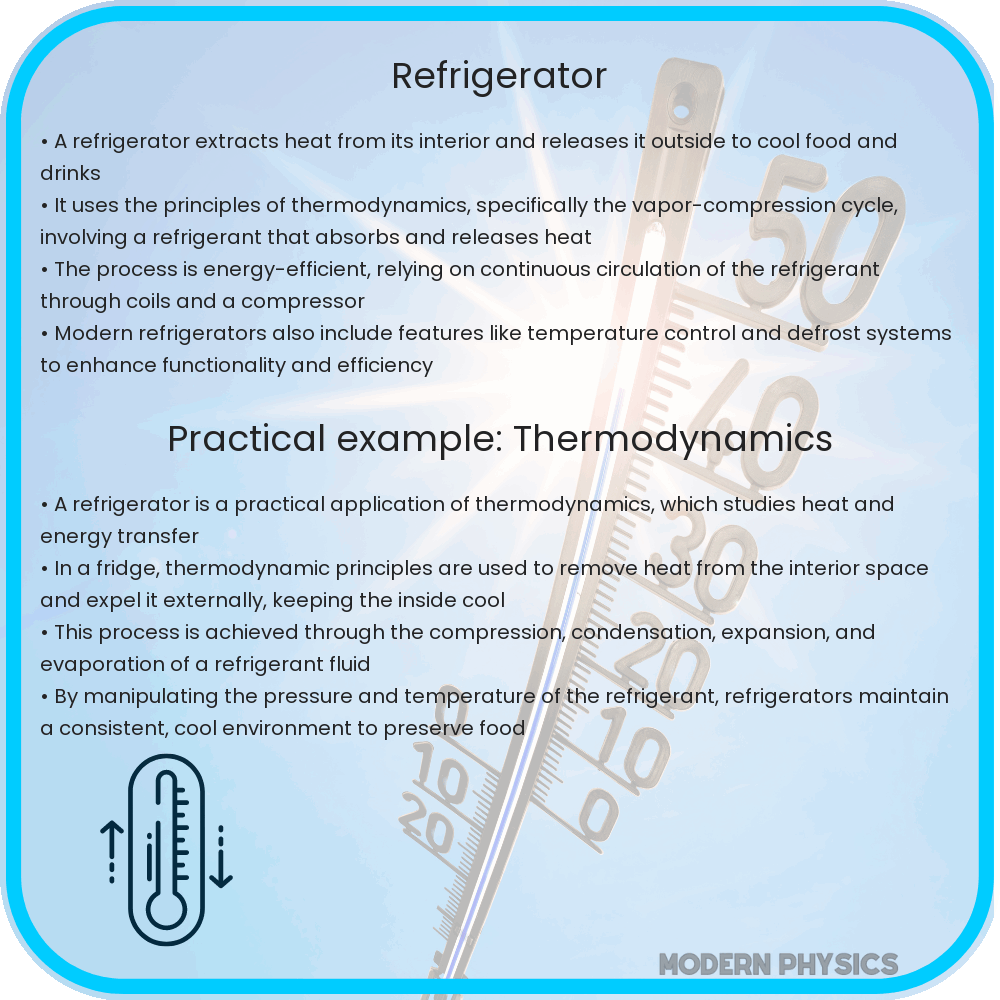Explore the efficiency of refrigerators through classical thermodynamics, covering technology advancements, Energy Star ratings, and practical tips.

Understanding Refrigerator Efficiency: A Classical Thermodynamics Perspective
The science of refrigeration is a fascinating application of classical thermodynamics and conservation principles. Refrigerators, essential appliances in modern households, operate on the principles of heat transfer and energy conservation. This article delves into the underlying thermodynamic concepts that govern refrigerator efficiency and how they align with conservation laws.
The Basics of Refrigerator Operation
A refrigerator’s primary function is to remove heat from its interior and release it into the surrounding environment. This process, governed by the First Law of Thermodynamics, involves the conservation of energy. The law, stated as ΔU = Q - W, where ΔU is the change in internal energy, Q is the heat added to the system, and W is the work done by the system, is central to understanding refrigerator operations.
In refrigeration, the Second Law of Thermodynamics also plays a crucial role. It posits that heat naturally flows from a warmer body to a cooler one. Refrigerators, however, reverse this flow by using work (usually electrical energy) to transfer heat from a colder interior to a warmer exterior.
Components and Their Functions
The efficiency of a refrigerator largely depends on its components:
- Compressor: Increases the pressure and temperature of the refrigerant, aiding in its transformation from a gas to a liquid.
- Condenser Coils: Allow the high-pressure refrigerant to dissipate heat and condense into a liquid.
- Expansion Valve: Reduces the pressure of the refrigerant, leading to a drop in temperature.
- Evaporator Coils: The cold refrigerant absorbs heat from the refrigerator’s interior, effectively cooling it down.
These components work in a cycle, continually transferring heat from inside the refrigerator to the outside environment. This cycle is a practical demonstration of energy conservation and thermodynamics in action.
Measuring Refrigerator Efficiency
Refrigerator efficiency is measured by the coefficient of performance (COP), defined as the ratio of the heat removed from the refrigerator’s interior to the work input required to remove it. Mathematically, it’s expressed as COP = QL / W, where QL is the heat removed and W is the work done. A higher COP indicates a more efficient refrigerator, as it requires less energy to remove a given amount of heat.
Several factors affect refrigerator efficiency, including insulation quality, door seals, and the efficiency of the compressor. Modern refrigerators also incorporate features like inverter technology to optimize the compressor’s operation, further enhancing efficiency.
Understanding the principles of thermodynamics and conservation helps in appreciating the technological marvel that is the refrigerator. It also provides insights into how improvements can be made for more energy-efficient designs, which are crucial in a world increasingly conscious of energy usage and its environmental impact.
Advancements in Refrigerator Technology
Recent advancements in refrigerator technology have focused on enhancing efficiency and reducing environmental impact. Innovations include the use of more efficient compressors, improved insulation materials, and eco-friendly refrigerants. For instance, newer models are increasingly using refrigerants with lower global warming potential (GWP), aligning with environmental sustainability goals.
Smart technology integration is another leap forward. Modern refrigerators come equipped with sensors and microprocessors that optimize cooling cycles, reduce energy consumption, and even alert users about maintenance needs or energy usage patterns.
Energy Star Ratings and Consumer Choice
Energy Star ratings, a widely recognized standard, play a significant role in guiding consumer choice towards more efficient appliances. Refrigerators with higher Energy Star ratings consume less electricity compared to their counterparts, making them more cost-effective in the long run despite a potentially higher upfront cost. This rating system encourages manufacturers to continually improve the energy efficiency of their products.
Practical Tips for Enhancing Efficiency
Beyond technological advancements, users can take practical steps to enhance their refrigerator’s efficiency:
- Regular Maintenance: Keeping the refrigerator clean, especially the coils, ensures efficient heat transfer.
- Proper Placement: Ensuring adequate space around the refrigerator for air circulation can significantly improve efficiency.
- Minimizing Door Openings: Keeping the door closed as much as possible prevents warm air from entering and reduces the workload on the compressor.
- Optimal Temperature Settings: Setting the refrigerator at the manufacturer-recommended settings avoids unnecessary overcooling.
Conclusion
The intersection of classical thermodynamics and modern technology in refrigerator design illustrates a remarkable journey of innovation and efficiency. By understanding the core principles of heat transfer and energy conservation, we gain insight into the workings of these everyday appliances. The ongoing advancements in refrigerator technology, coupled with conscious consumer practices, contribute significantly to energy conservation and environmental sustainability. As we move forward, the continuous improvement in refrigerator efficiency not only exemplifies technological progress but also reflects our growing commitment to a more energy-conscious world.
